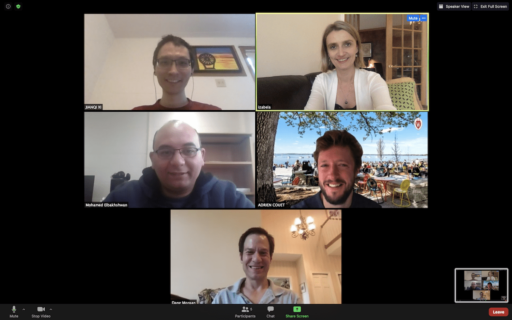Neutrinos are one of the most common subatomic particles in the universe. However, with a mass close to zero and no electric charge, they are difficult to study because they rarely interact with matter. To observe them, scientists have gone to great lengths, including building the University of Wisconsin-Madison’s giant IceCube observatory in the ice of Antarctica.
One of the most reliable methods of producing neutrinos for study is using a particle accelerator. The massive machines speed up beams of high-energy protons to near the speed of light. When those beams smash into a specially designed target or beam window, they break into subatomic pieces, which then decay into neutrinos that researchers observe using specialized detectors.
 Top: Postdoctoral scholar Jianqi Xi, Professor Izabela Szlufarska; middle row: Staff scientist Mohamed Elbakhshwan, Assistant Professor Adrien Couet; bottom row: Professor Dane Morgan
Top: Postdoctoral scholar Jianqi Xi, Professor Izabela Szlufarska; middle row: Staff scientist Mohamed Elbakhshwan, Assistant Professor Adrien Couet; bottom row: Professor Dane Morgan
That process will be important in the new Long-Baseline Neutrino Facility at Fermi National Accelerator Laboratory which hosts the Deep Underground Neutrino Experiment (DUNE). DUNE will eventually send trillions of neutrinos 800 miles underground from Illinois to detectors in South Dakota.
However, getting blasted with proton beams takes a toll on those beam-intercepting devices, which are often thin pieces of metal, and they begin to break down after exposure to extreme conditions (mainly from radiation damage and thermo-mechanical stress). As researchers begin to consider upgrading existing accelerators and building more powerful models, the durability of those devices is a major concern.
“Every time a target is destroyed, it needs to be replaced, which means that the experiments have to be interrupted. That affects scientists all around the world whose research depends on data generated from these accelerators,” says Izabela Szlufarska, a professor of materials science and engineering at UW-Madison and principal investigator in a new collaboration with Fermilab to study and improve the durability of those devices. “A critical issue for next-generation accelerators is extending the lifetime of the targets by identifying and designing materials that can withstand extreme radiation damage and thermophysical shock. In fact, development of next-generation major accelerator facilities has been limited by their target facilities.”
With the aid of a $1.1 million research grant from the U.S. Department of Energy High Energy Physics Program, Szlufarska and her co-investigators, Materials Science and Engineering Professor Dane Morgan and nuclear engineering and engineering physics Assistant Professor Adrien Couet, will model and test the durability of beryllium-based target materials.
The current generation of neutrino targets is made primarily of graphite, which produces particles with the right energy to decay into neutrinos when bombarded by protons. However, since next generation reactors are designed to operate at higher energies and beam power, new materials are also being considered to withstand the harsh environments of future accelerators.
Beryllium and its alloys are promising replacements since they are also capable of producing neutrino-generating particles while having a better radiation resistance than graphite. Testing and assessing the beryllium, however, requires special handling since it is toxic. And, after their use, any target material becomes quite radioactive, requiring scientists to use manipulators to handle materials in shielded chambers called “hot cells.” Given the time and precautions involved, studying beryllium target materials in a full-scale particle accelerator is not ideal.
That’s why Szlufarska and Morgan plan to first model and predict the evolution of radiation damage effects in the beryllium with a special focus on helium bubble formation. Then Couet’s group, which has experience handling beryllium and which operates and manages the UW-Madison Ion Beam Laboratory to study irradiation damage in materials, will experimentally test those models. Though the UW-Madison ion beam is not nearly as powerful as the accelerators at Fermilab, it will be critical in carrying out controlled radiation studies to discover the impact of beam radiation on the material.
The ambitious goal of the project is for the modeling and testing to narrow the field of beryllium microstructures and alloys worth assessing at the High Power Targetry R&D program at Fermilab, saving time and money, and to develop a framework in which other materials can be explored and tested. In fact, the team is already in talks about exploring new materials, such as high-entropy alloys.
Szlufarska says this collaboration opens up new opportunities to bring in expertise from research on materials for nuclear energy reactors to research on particle accelerators and to cross-pollinate ideas.
It is also an opportunity for the UW-Madison College of Engineering team to join a large international effort on development of materials for accelerators. Though the DOE funding began in July 2020, the team launched its research with a seed grant in 2019. They have already started a collaboration with colleagues in Germany and the United Kingdom and Szlufarska gave a talk at CERN, the European Organization for Nuclear Research and operator of the Large Hadron Collider, the massive particle accelerator in Switzerland. “This funding allows us to be part of this vibrant international community,” says Szlufarska. “It’s very exciting.”
Izabela Szlufarska is Harvey D. Spangler Professor of Engineering and chair of the UW-Madison Department of Materials Science and Engineering. Dane Morgan is Harvey D. Spangler Professor of Engineering.